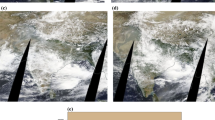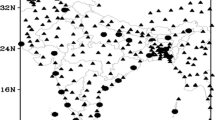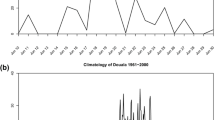Abstract
The WRF-based real-time forecast system (http://jhwc.snu.ac.kr/weather) of the Joint Center for High-impact Weather and Climate Research (JHWC) has been in operation since November 2006; this system has three nested model domains using GFS (Global Forecast System) data for its initial and boundary conditions. In this study, we evaluate the improvement in daily and hourly weather prediction, particularly the prediction of summer rainfall over the Korean Peninsula, in the JHWC WRF (Weather Research and Forecasting) model system by 3DVAR (three-Dimensional Variational) data assimilation using the data obtained from KEOP (Korea Enhanced Observation Program). KEOP was conducted during the period June 15 to July 15, 2007, and the data obtained included GTS (Global Telecommunication System) upper-air sounding, AWS (Automatic Weather System), wind profiler, and radar observation data. Rainfall prediction and its characteristics should be verified by using the precipitation observation and the difference field of each experiment. High-resolution (3 km in domain 3) summer rainfall prediction over the Korean peninsula is substantially influenced by improved synoptic-scale prediction in domains 1 (27 km) and 2 (9 km), in particular by data assimilation using the sounding and wind profiler data. The rainfall prediction in domain 3 was further improved by radar and AWS data assimilation in domain 3. The equitable threat score and bias score of the rainfall predicted in domain 3 indicated improvement for the threshold values of 0.1, 1, and 2.5 mm with data assimilation. For cases of occurrence of heavy rainfall (7 days), the equitable threat score and bias score improved considerably at all threshold values as compared to the entire period of KEOP. Radar and AWS data assimilation improved the temporal and spatial distributions of diurnal rainfall over southern Korea, and AWS data assimilation increased the predicted rainfall amount by approximately 0.3 mm 3hr−1.
Similar content being viewed by others
References
Anthes, R. A., Y.-H. Kuo, D. P. Baumhefner, R. M. Erico, and T.W. Bettge, 1985: Predictability of mesoscale atmospheric motions. Adv. Geophys., 28B, 159–202.
Barker, D. M., W. Huang, Y.-R. Guo, and A. Bourgeois, 2003: A three dimensional variational (3DVAR) data assimilation system for use with MM5. NCAR Tech. Note NCAR/TN-453STR, 68 pp.
_____, ______, ______, ______, and Q. Xiao, 2004: A three-dimensional variational (3DVAR) data assimilation system for MM5: Implementation and initial results. Mon. Wea. Rev., 132, 897–914.
Benjamin, S. G., and Coauthors, 2004a: An hourly assimilation/forecast cycle: The RUC. Mon. Wea. Rev., 132, 495–518.
_____, G. A. Grell, J. M. Brown, and T. G. Smirnova 2004b: Mesoscale weather prediction with the RUC hybrid isentropic-terrain-following coordinate model. Mon. Wea. Rev., 132, 473–494.
Caya, A., J. Sun. and C. Snyder, 2005: A comparison between the 4D-Var and the ensemble Kalman filter techniques for radar data assimilation. Mon. Wea. Rev., 133, 3081–3094.
Chen, S., J. E. Nachamkin, J. M. Schmidt, and C.-S. Liou, 2002: Quantitative precipitation forecast for the coupled ocean/atmosphere mesoscale prediction system (COAMPS). 19th Conf. on Weather Analysis and Forecasting/15 th Conf. on Numerical Weather Prediction, San Antonio, TX, Amer. Meteor. Soc., 7B.1. [Available online at http://ams.confex.com/ams/pdfpapers/47727.pdf.]
Chien, F.-C., Y. H. Kuo, and M.-J. Yang, 2002: Precipitation forecast of MM5 in the Taiwan area during the 1998 Mei-yu season. Wea. Forecasting, 17, 739–754.
Clark, A. J., W. A. Gallus, and T. C. Chen, 2007: Comparison of the diurnal precipitation cycle in convective resolving and non-convectionresolving mesoscale models. Mon. Wea. Rev., 35, 3456–3473.
Colle, B., J. B. Olson, and J. S. Tongue, 2003a: Multiseason verification of the MM5. Part I: Comparison with the Eta model over the central and eastern United States and impact of MM5 resolution. Wea. Forecasting, 18, 431–457.
_____, ______, and ______, 2003b: Multiseason verification of the MM5. Part II: Evaluation of high-resolution precipitation forecasts over the northeastern United States. Wea. Forecasting, 18, 458–480.
Davis, C. A., K. W. Manning, R. E. Carbone, S. B. Trier, and J. D. Tuttle, 2003: Coherence of warm-season continental rainfall in numerical weather prediction models. Mon. Wea. Rev., 131, 2667–2679.
Grell, G. A., J. Dudhia, and D. R. Stauffer, 1994: A description of the fifth-generation Penn State-NCAR Mesoscale Model (MM5). NCAR Tech. Note NCAR/TN-398+STR, 122 pp.
Guo, Y.-R., J. Sun, E. Lim, X.-Y. Huang, X. Zhang, and S. Sugimoto, 2008: Assimilation of Doppler radar data with WRF 4DVAR for a convective case. 9th WRF Users’ Workshop, Boulder, Colorado. [Available online at http://www.mmm.ucar.edu/wrf-/users/workshops/WS2008/-abstracts/P5-06.pdf.]
Huang, X.-Y., and Coauthors, 2009a: Four-dimensional variational data assimilation for WRF: Formulation and preliminary results. Mon. Wea. Rev., 137, 299–314.
Jollie, I. T. and D. B. Stephenson, 2003: Forecast Verification: A Practitioner’s Guide in Atmospheric Science. Wiley and Sons Ltd., 254 pp.
Joly, A., and Coauthors, 1999: Overview of the field phase of the Front and Atlantic Storm-Track Experiment (FASTEX) project. Quart. J. Roy. Meteor. Soc., 125, 3131–3163.
Jung, J.-H., and M.-S. Suh, 2005: Characteristics and types of the diurnal variation of hourly precipitation during rainy season over South Korea. J. Korean Meteor. Soc., 41, 533–546. (in Korean with English abstract)
Kim, H.-H., and S.-K. Park, 2008: Current Status of Intensive Observing Period and Development Direction. Atmosphere, 18, 147–158. (in Korean with English abstract)
Kim. H.-W., and D.-K. Lee, 2006: An Observational Study of Mesoscale Convective Systems with Heavy Rainfall over the Korean Peninsula. Wea. Forecasting, 21, 125–148.
Kuo, Y.-H., and G. T.-J. Chen, 1990: The Taiwan Area Mesoscale Experiments: An overview. Bull. Amer. Meteor. Soc., 71, 488–503.
Langland, R. H., and Coauthors, 1999: The North Pacific Experiment (NORPEX-98): Targeted observations for improved North American weather forecasts. Bull. Amer. Meteor. Soc., 80, 1364–1384.
Lee, D.-K., S.-Y. Hong, and S.-O. Hwang. 1991: Evolution of mesoscale feature associated with two extremely heavy rainfall events occurred over the Korean Peninsula. Proc. Int. Conf. on Mesoscale Meteorology and TAMEX, Taipei, Taiwan, Taiwan Meteor. Soc. and Amer. meteor. Soc., 284–288.
_____, H.-R. Kim, and S.-Y. Hong, 1998: Heavy rainfall over Korea during 1980–1990. Korean J. Atmos. Sci., 1, 523–547. (in Korean with English abstract)
_____, J.-W. Kim, D.-Y. Eom, S.-J. Choi, and J.-H. Ha, 2008a: WRF Real-Time Operation at JHWC-GPP. 2nd East Asia WRF Workshop and Tutorial, Seoul, Korea. [Available online at http://jhwc.snu.ac.kr/wrf2008/workshop_ppt/2-1.pdf.]
_____, J.-G. Park, and J.-W. Kim, 2008b: Heavy Rainfall Events Lasting 18 Days from July 31 to August 17, 1998, over Korea. J. Meteor. Soc. Japan, 86, 313–333.
_____, J.-W. Kim, D.-Y. Eom, S.-J. Choi, and J.-H. Ha, 2009: Data assimilation of the JHWC real-time WRF system. 3rd East Asia WRF Workshop and Tutorial, Seoul, Korea. [Available online at http://jhwc.snu.ac.kr/wrf2009/presentation/1/1-5.ppt]
Lee, W.-C., and Ben J.-D. Jou, 2008: An overview of SoWMEX/TiMREX operation. 1st SoWMEX/TiMREX Science Workshop, Taipei, Taiwan. [Available online at http://sowmex.cwb.gov.tw/2008/showppt.php?SessW=17_DongKyouLee&-pptDate=20081106.]
Lim, G.-H., and H.-J. Kwon, 1998: Diurnal variation of precipitation over South Korea and its implication. J. Korean Meteor. Soc., 34, 222–237. (in Korean with English abstract)
Misumi, Y., 1999: Diurnal variations of precipitation grouped into cloud categories around Japanese archipelago in the warm season. J. Meteor. Soc. Japan, 77, 615–635.
Ninomiya, K., and C. Kobayashi, 1998: Precipitation and moisture balance of the Asian summer monsoon in 1991. Part I: Precipitation and major circulation systems. J. Meteor. Soc. Japan, 76, 855–877.
Park, S.-G., and D.-K. Lee, 2009: Retrieval of high-resolution wind fields over southern Korean Peninsula using doppler weather radar network. Wea. Forecasting, 24, 87–103.
Skamarock, W. C., J.B. Klemp, J. Dudhia, D. O. Gill, D. M. Barker, W. Wang, and J. G. Powers, 2005: A description of the Advanced Research WRF Version 2. NCAR Tech. Note 468STR, 88 pp.
Sun, J., and T.-Y. Lee, 2002: A numerical study of an intense quasistationary convection band over the Korean Peninsula. J. Meteor. Soc. Japan, 80, 1221–1245.
Warner, T. T., R. A. Peterson, and R. E. Treadon, 1997: A tutorial on lateral boundary conditions as a basic and potentially serious limitation to regional numerical weather prediction. Bull. Amer. Meteor. Soc., 78, 2599–2617.
Weckwerth, T. M., D. B. Parsons, S. E. Koch, J. A. Moore, M. A. Lemone, B. B. Demoz, C. Flamant, B. Geerts, J. Wang, and W. F. Feltz, 2004: An overview of the international H2o project (IHOP_2002) and some preliminary highlights. Bull. Amer. Meteor. Soc., 85, 253–277.
Weisman, M. L., and R. J. Trapp, 2003: Lowlevel mesovortices within squall-lines and bow echoes: Part I. Overview and dependence on environmental shear. Mon. Wea. Rev., 131, 2779–2803.
Author information
Authors and Affiliations
Corresponding author
Rights and permissions
About this article
Cite this article
Lee, DK., Eom, DY., Kim, JW. et al. High-resolution summer rainfall prediction in the JHWC real-time WRF system. Asia-Pacific J Atmos Sci 46, 341–353 (2010). https://doi.org/10.1007/s13143-010-1003-2
Received:
Revised:
Accepted:
Published:
Issue Date:
DOI: https://doi.org/10.1007/s13143-010-1003-2




